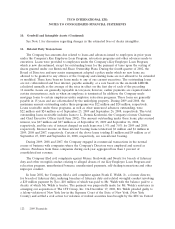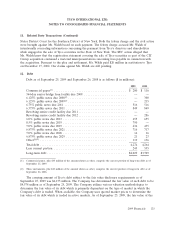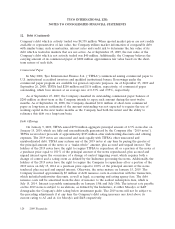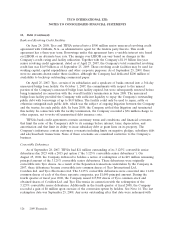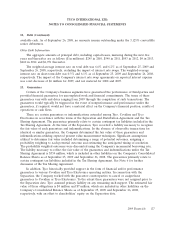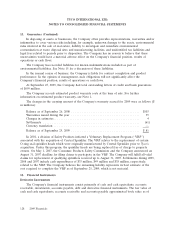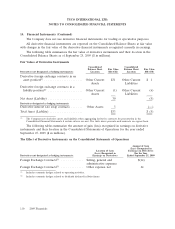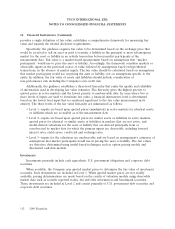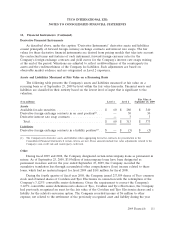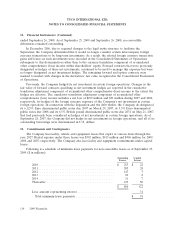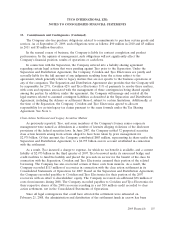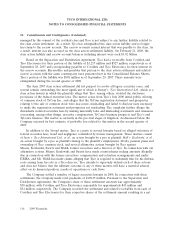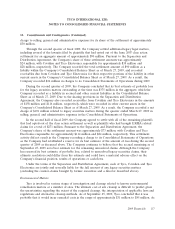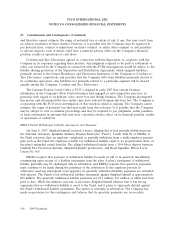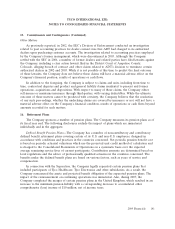ADT 2009 Annual Report Download - page 223
Download and view the complete annual report
Please find page 223 of the 2009 ADT annual report below. You can navigate through the pages in the report by either clicking on the pages listed below, or by using the keyword search tool below to find specific information within the annual report.
TYCO INTERNATIONAL LTD.
NOTES TO CONSOLIDATED FINANCIAL STATEMENTS
14. Financial Instruments (Continued)
As of September 25, 2009, the total gross notional amount of the Company’s foreign exchange
contracts was approximately $525 million.
Amount of Gain
(Loss) Recognized in
Location of Gain Earnings on Derivatives
(Loss) Recognized in For the Year
Derivatives designated as hedging instruments: Earnings on Derivatives Ended September 25, 2009
Interest Rate Swap Contracts(1) ............. Interest expense $3
(1) The gain or loss on the derivative as well as the offsetting loss or gain on the hedged item attributable to the hedged risk
are recognized in current earnings. The Company includes the gain or loss on the hedged item in the same line item,
interest expense, as the offsetting loss or gain on the related interest rate swaps. For the year ended September 25, 2009,
the Company recognized a $3 million loss on the underlying debt issuances.
As of September 25, 2009, the total gross notional amount of the Company’s interest rate swap
contracts was $1.4 billion.
Counterparty Credit Risk
The use of derivative financial instruments exposes the Company to counterparty credit risk. If the
counterparty fails to perform, the Company is exposed to losses if the derivative is in an asset position.
When the fair value of a derivative instrument is an asset, the counterparty has to pay the Company to
settle the contract. This exposes the Company to credit risk. However, when the fair value of a
derivative instrument is a liability, the Company has to pay the counterparty to settle the contract and
therefore there is no counterparty credit risk. Tyco has established policies and procedures to limit the
potential for counterparty credit risk, including establishing limits for credit exposure and continually
assessing the creditworthiness of counterparties. As a matter of practice, the Company deals with major
banks worldwide having long-term Standard & Poor’s and Moody’s credit ratings of A-/A3 or higher. To
further reduce the risk of loss, the Company generally enters into International Swaps and Derivatives
Association master agreements with substantially all of its counterparties. Master netting agreements
provide protection in bankruptcy in certain circumstances and, in some cases, enable receivables and
payables with the same counterparty to be offset on the Consolidated Balance Sheets, providing for a
more meaningful balance sheet presentation of credit exposure. The Company’s derivative contracts do
not contain any credit risk related contingent features and do not require collateral or other security to
be furnished by the Company or the counterparties.
The Company’s exposure to credit risk associated with its derivative instruments is measured on an
individual counterparty basis, as well as by groups of counterparties that share similar attributes. As of
September 25, 2009, the Company was exposed to industry concentration with financial institutions as
well as risk of loss if an individual counterparty or issuer failed to perform its obligations under
contractual terms. The maximum amount of loss that the Company would incur, without giving
consideration to the effects of legally enforceable master netting agreements, is approximately
$32 million.
Fair Value of Financial Instruments
Effective September 27, 2008 the Company adopted the authoritative guidance for fair value
measurements for all financial assets and liabilities as well as non-financial assets and liabilities that are
recognized or disclosed at fair value in the financial statements on a recurring basis. The guidance
2009 Financials 131



